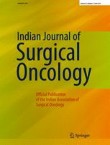
Abstract
Background
Minimally invasive colorectal surgery has demonstrated to have the same oncological results as open surgery, with better clinical outcomes. Robotic assistance is an evolution of minimally invasive technique.
Purpose
The study aims to present technical details and short-term oncological outcomes of robotic-assisted complete mesocolic excision (CME) with central vascular ligation (CVL) for right colon cancer.
Methodology
Fifty-two consecutive patients affected by right colon cancer were operated between May 2016 and February 2020 with da Vinci Xi platform. Data regarding surgical and short-term oncological outcomes were systematically collected in a colorectal specific database for statistical analysis.
Results
Thirty-seven (71.15%) and 15 (28.85%) patients underwent right and extended right hemicoletomy with an extracorporeal anastomosis. Median age was 55 years. Mean operative time was 182 ± 36 min. Mean blood loss was 110 ± 90 ml. Conversion rate was 3.84% (two cases). 78.84% (41 cases) were pT3 and mean number of harvested lymph nodes was 28 ± 4. 1/52 (1.92%) had a documented anastomotic leak requiring exploratory laparotomy and diversion proximal ileostomy. Surgery-related grade IIIa–IIIb Calvien Dindo morbidity were noted in 9.61% and 1.92%, respectively.
Conclusion
Robotic assistance allows performance of oncological adequate dissection of the right colon with radical lymphadenectomy as in open surgery, confirming the safety and oncological adequacy of this technique, with acceptable results and short-term outcomes.



